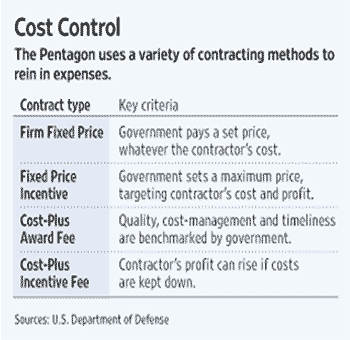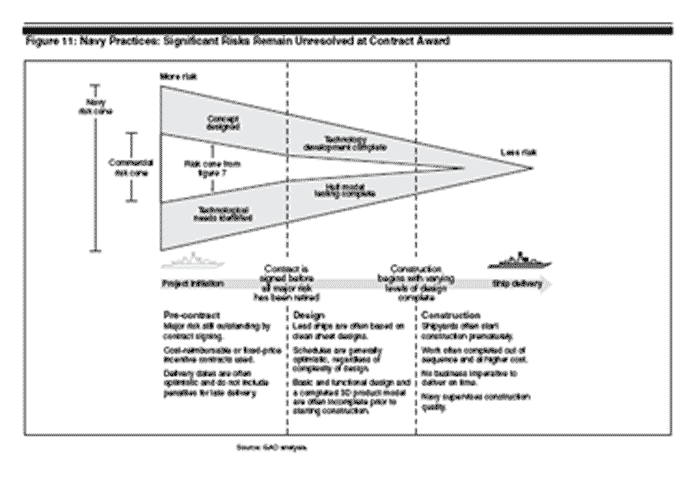Challenges Facing Widespread Use of Firm-Fixed Price (FFP) Contracts in the Defense Sector
A Way to Shape Acquisition Reform
The Obama Administration seeks to apply firm-fixed price contracting in a number of sectors, including defense. Indeed, it appears that the Administration equates the use of this contract vehicle with the ability to shape acquisition reform.(e.g. see the use of firm fixed price contracting under the stimulus bill or in defense contracting).
Recently, the Wall Street Journal published a cautionary note on the widespread application of such an approach in large-scale programs subject to significant development challenges and approaches (see Dan Michaels and August Cole, WSJ, December 14, 2009 ).
The authors note that Now the Obama administration wants to use fixed-price deals as one tool to permanently shake up defense contracting and cut its cost of military systems. In August, the Pentagon awarded an Army truck contract worth billions of dollars to Oshkosh Corp. on a fixed-price basis. BAE, whose subsidiary had held the contract for 17 years, and another bidder, Navistar International Corp., lodged protests with Government Accountability Office to challenge the Army’s pick. Oshkosh’s lower pricing is an issue with the losing companies.
They add a cautionary note from a senior Boeing official:
Boeing Chief Financial Officer James Bell said recently that the company was taking its concerns to the Air Force. “Fixed price development is a tough contract,” he told a conference. “It is very, very difficult.”
Pre-conditions (for Success) to Fixed Price Contracting
This month I would like to share some of my views on the critical factors that should be used in fixed price contracting.
Among the most significant in shaping a successful fixed price contract are the following:
- Relatively straightforward or simple technical problem
- Experienced program team
- Very good program management tools
- Mature technologies
- Follow-on production
These key factors allow us to then ask the core question: Do we have those factors in place when we decide to use fixed priced contracts in today’s environment?
Under current congressional pressure, the use of FFP contracts is considered the contract type of choice to use for our major development and procurement programs. I would like to share some of my past experiences (more like scars) in this area and what I have learned as the factors to use in selection of contract type.
First, however a basic understanding of classical contract types will be useful. Specifically types of contracts fall into two broad categories, fixed price and cost reimbursable. The WSJ article outlined the key approaches used in contacting which are identified in the following graphic:

FFPs are designed for procurements and developments where the work is clearly understood and the risk to develop and deliver is low. Cost reimbursable type contracts are used with more complex and less defined /developed program content and the risk is considered to be much higher. These types of contracts normally include provisions for risk sharing between the government and the contractor.
The theory is that in a fixed price environment the cost risk is on the contractor and in a cost reimbursable environment the cost risk is on the Government. The perception is that fixed price contracts are guarantees of performance for a fixed price while cost reimbursable contracts are open ended – both performance and funding-wise.
This simplistic view has, in the past, driven us to impose fixed price contracts on work scopes for which they just weren’t appropriate in the mistaken belief that the Government’s risk had been bounded by the fixed price. Some current acquisition strategies try to use contract types as the singular tool for contractor behavior management. From my experience, such a strategy has some serious flaws. We have learned from the past that a “perfect” contract does not exist and contract type alone does not afford successful program execution.
Rather, a combination of many factors is required to pull off successful contract performance. The primary tenets I advocate for successful program execution include a clear understanding of the requirement, good communications/transparency, superior program management tools (near real time earned value insight, risk management process,) and motivated /experienced workers to pull it off.

The practice of using fixed price contracts as the best way to control contractor performance behavior is again in vogue. I think this practice requires further consideration and a review of our past performance in this area before elevating this approach to a core principle for successful acquisition reform. Program success and successful contractor performance is more complex than selecting a type of contract.
It requires developing a solid acquisition strategy. This starts with the foundation of a sound risk assessment including, clear understanding of the technology involved. Contract type should be selected based upon the above plus other considerations including management factors such as management team experience, robust real time tracking systems (for cost and schedule), solid system engineering planning — all of these factors play in developing a sound acquisition strategy.
So one should do a lot of homework to ensure that contract type matches your risk, skill and likely bidders’ past performance. One hat does not fit all and one type contract does not fit all major development programs. Matching the appropriate type of contract to the procurement is an art form that is at the foundation of successful acquisition practices and reform.
Lessons Learned from the A-6E and A-6F programs
The past is often a good predictor of the future so we may learn valuable lessons from it, if we are vigilant. As a young government employee working in several program offices in the late 80’s I got firsthand experience on the complexity of using FFP contracts for development programs. At that time I was the deputy program manager of the A-6 / EA-6 program office and had the opportunity to try my hand at managing fixed priced development efforts.
Two of the programs we had in this situation were the A-6F Program and the A-6E Re-wing Program. The recurring headache in these FFP environments was distinguishing between ‘in scopeand out of scope’ efforts. ‘In scope’ effort was straightforward, it was something that was considered to be a baseline requirement of the fixed price contract. The challenge was to demonstrate that the requirement was (or wasn’t) was included in the priced contract baseline and no cost or schedule impact would be allowedfor performance of the effort. This type of issue often occurred in areas of specific specification compliance.
In other words, the contractor might argue that a specific performance level was specification compliance for a particular technical parameter. We had very experienced engineers and contracts folks who were able to conduct an analysis to affirm or rebut the contractor’s assertion The contractor also had a skilled workforce to hold up their end of the dialogue. A single technical requirements oversight by the government resulting in an ‘out of scope’ determination could cause serious cost increases. If a needed technical requirement found to be ‘out of scope’ of the fixed price contract, we would have to develop changed requirements, get it priced out, secure funding and add it to the contract.
This was not an easy process; rather, it required both complex and timeliness to execute. This process was further complicated by the fact that virtually all of the program’s funding was already tied up in the firm, fixed price of the contract.
If you had a hundred or so of these types of changes (not uncommon on a complex weapon system development) program, you had a second full time job. We should always keep in mind that developing complex weapon systems is not easy. Some design iteration is always required. To say “no changes allowed” is just not realistic. I saw some of my peers have similar challenges on the F-14D, P-7, and A-12 to name a few of the fixed priced development programs that ended up being canceled. With many billions spent in development we only got a few flying prototype aircraft and a few parts and a bunch of paper and some lawsuits.
The difference between then and now is that I believe we had more program dollars in those days and a more experienced work force. Most of our engineers, contracts officers and managers had broad experience from working on multiple programs over the course of their careers.
I hope that we can be informed from our past experiences as we develop future program acquisition strategies. We must also consider matching the procurement approach with people and tools that can lead to successful program execution. Using the right contract type with the right management tools and with the right people trained to execute the contract on both the government and contractor sides is essential to successful contracting. Blindly following a fixed-price contract mantra will not get you there. Fixed-price contracting is not pixie dust.
———-
***Posted January 9th, 2010

